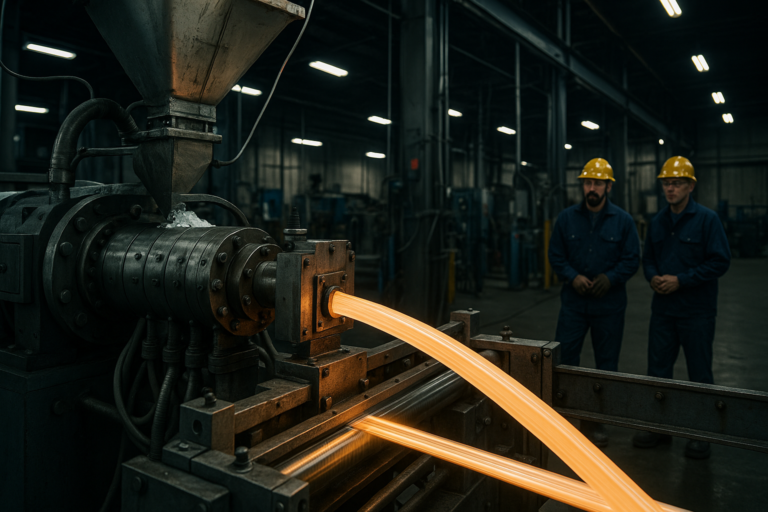إجراء بعض التغييرات على البيئة العالمية
-
المبنى 3، مدينة وانيانغ للابتكار، شارع لانغشيا، مدينة يوياو، مقاطعة تشجيانغ
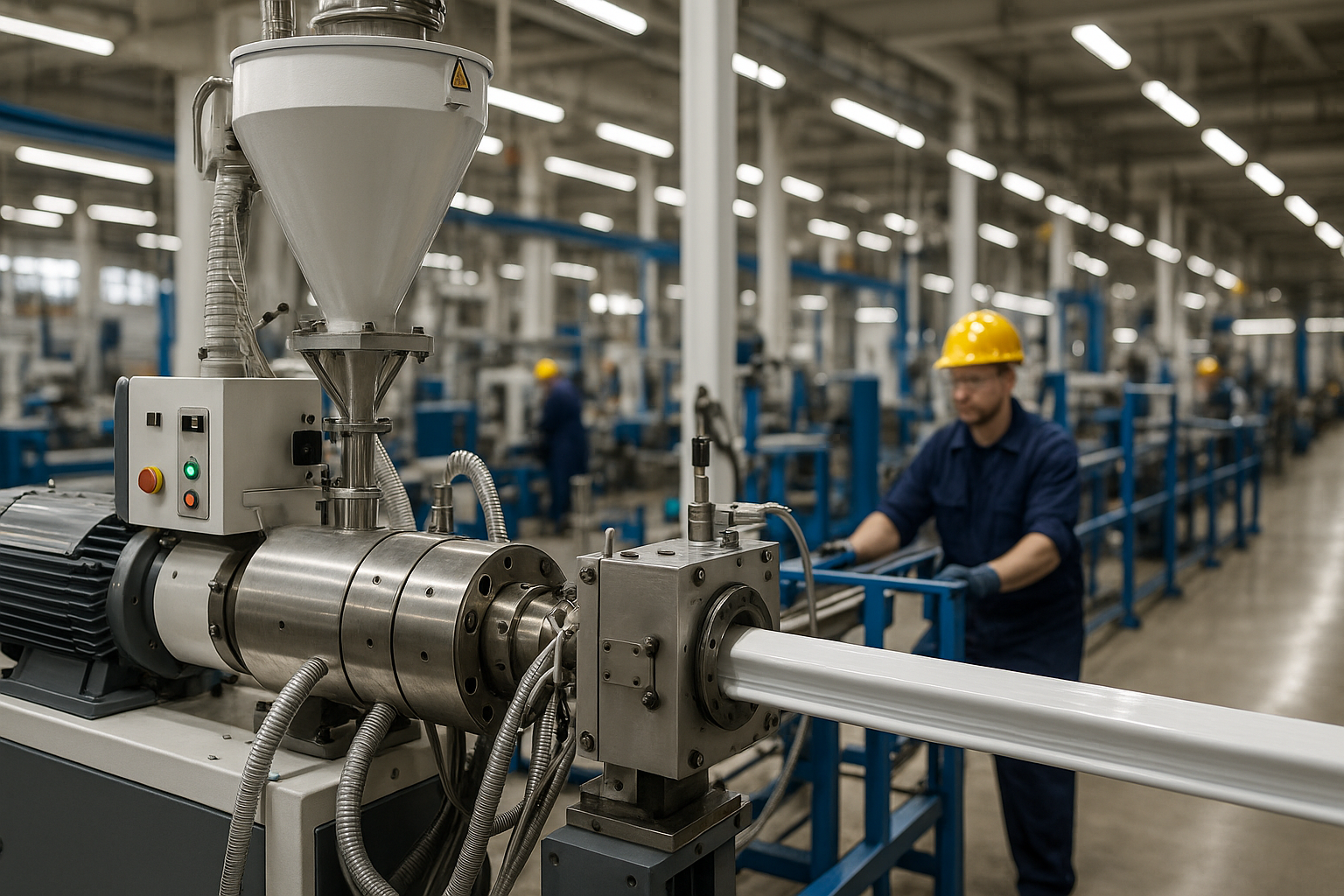
اصطفوا للنجاح مع اختيارات معدات بثق البلاستيك هذه
استكشف أفضل اختيارات معدات بثق البلاستيك لتحقيق الكفاءة والجودة. حسِّن عملية التصنيع لديك من خلال رؤى الخبراء.
#P5T# الدليل الأساسي لمعدات بثق البلاستيك
معدات بثق البلاستيك تشكل العمود الفقري لعمليات التصنيع الحديثة التي تحول المواد البلاستيكية الخام إلى منتجات لا حصر لها نستخدمها يوميًا. إذا كنت تستكشف خيارات معدات البثق، فإليك ما تحتاج إلى معرفته:
| نوع المعدات | الوظيفة الأساسية | الأفضل لـ | التطبيقات النموذجية |
|---|---|---|---|
| آلات البثق أحادية اللولب | المعالجة العامة للبلاستيك الحراري | التطبيقات القياسية ذات الحجم الكبير | الأنابيب والمقاطع الجانبية والصفائح |
| آلات البثق اللولبية المزدوجة | تحسين الخلط والمعالجة المركبة | المواد المعقدة والتطبيقات الحساسة | الملامح التخصصية، التركيب |
| أنظمة البثق المشترك | إنشاء منتج متعدد الطبقات | المنتجات التي تتطلب مواد متعددة | أغشية متعددة الطبقات، أنابيب مركبة |
| معدات المصب | معالجة ما بعد البثق | التشطيب وإعداد المنتجات النهائية | التبريد والقطع واللف |
تعمل عملية بثق البلاستيك على تحويل كريات البلاستيك الخام إلى أشكال مستمرة عن طريق صهر المواد وتشكيلها من خلال قوالب متخصصة. يعود تاريخ هذه التكنولوجيا إلى أكثر من 75 عامًا، حيث كان المبتكرون في هذا المجال روادًا في هذا المجال وما زالوا يشكلون هذا القطاع حتى اليوم.
بالنسبة إلى مديري التصنيع الذين يركزون على الاستدامة، توفر معدات البثق الحديثة مزايا كبيرة. كما يلاحظ أحد مزودي المعدات: "صُممت آلات البثق لدينا لمعالجة ما يصل إلى 100% من البلاستيك المعاد تدويره"، مما يعالج المخاوف البيئية وكفاءة الإنتاج على حد سواء.
يمكن أن يؤثر اختيار معدات البثق المناسبة تأثيرًا كبيرًا على جودة الإنتاج والكفاءة والبصمة البيئية. وبفضل الابتكارات مثل المحركات الموفرة للطاقة وأنظمة التحكم المتقدمة، يمكن لمعدات اليوم أن تقلل من استهلاك الطاقة بمقدار 10-15% مع تحسين الإنتاج بمقدار 20-30%.
عند تقييم معدات بثق البلاستيك، ضع في اعتبارك:
- توافق المواد مع البوليمرات الخاصة بك
- متطلبات حجم الإنتاج
- تصنيفات كفاءة الطاقة
- خيارات التخصيص
- قدرات التكامل في المراحل النهائية
من خلال اختيار المعدات التي تتوافق مع أهداف الإنتاج وأهداف الاستدامة لديك، يمكنك تقليل النفايات بشكل كبير مع تحسين عمليات التصنيع لديك.
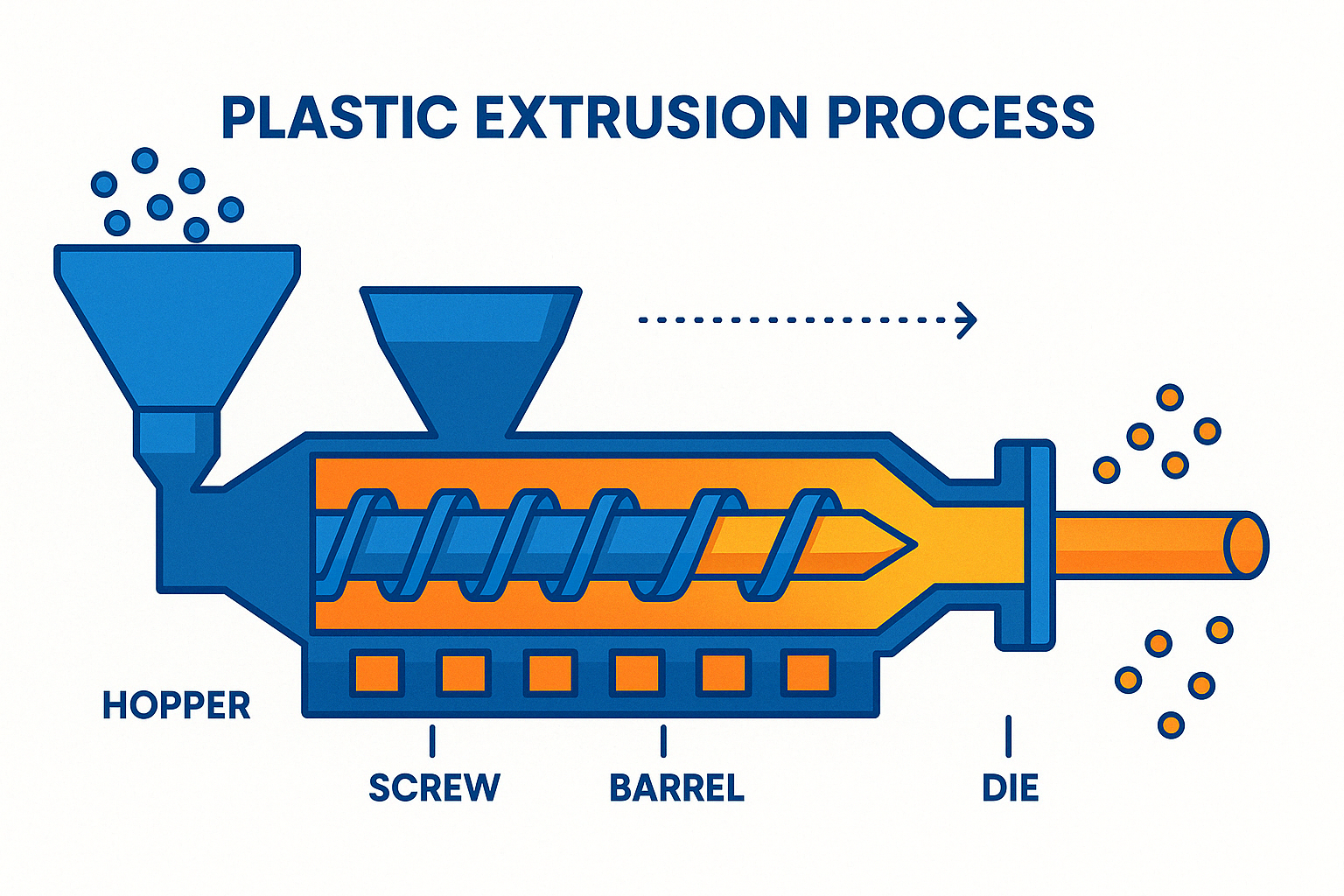
1. معدات بثق البلاستيك أحادية اللولب: العمود الفقري للتصنيع
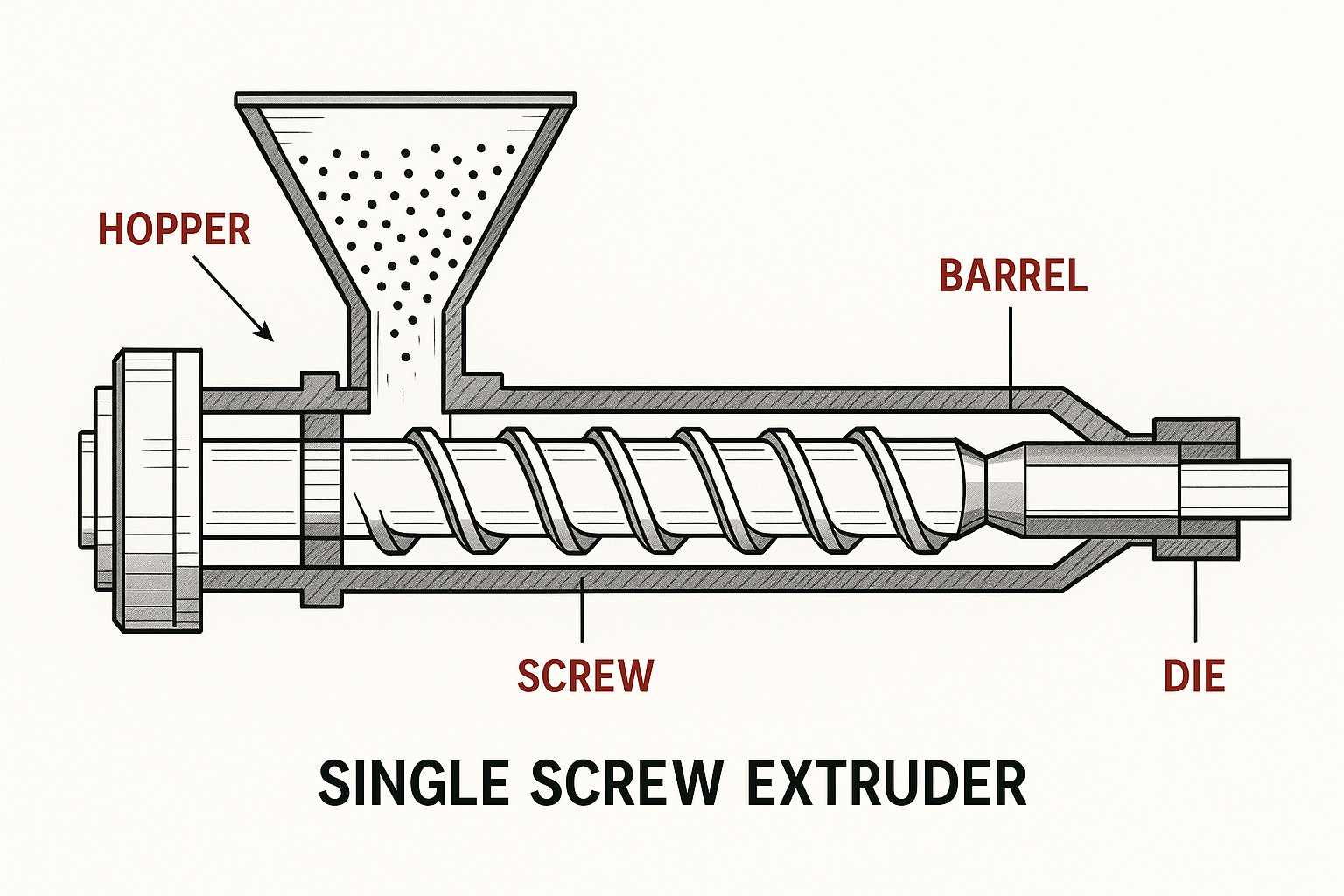
إذا كان لعالم تصنيع البلاستيك صديق مقرب موثوق به، فسيكون الطارد أحادي اللولب. هذه الماكينات الموثوق بها ليست شائعة فقط - فهي تمثل حوالي 70% من جميع معدات بثق البلاستيك المنشآت في جميع أنحاء العالم. وهذا ليس من قبيل الصدفة!
فكّر في آلات البثق أحادية اللولب باعتبارها حصان العمل الصبور الذي يحافظ على استمرار خطوط الإنتاج في الحركة يومًا بعد يوم. ويكمن جمالها في بساطتها: برغي دوار داخل برميل ساخن يحرك المواد البلاستيكية خلال رحلة رائعة. تدخل كريات البلاستيك الخام من خلال القادوس، ثم تنتقل على طول البرميل حيث يتم صهرها تدريجيًا عن طريق مزيج من الاحتكاك (من الحركة الميكانيكية للولب) والحرارة الخارجية. وبعد ذلك يتم دفع هذا البلاستيك المنصهر من خلال قالب مصمم خصيصًا لإنشاء مقاطع جانبية متواصلة بأبعاد متناسقة.
هنا في جيان تاي تُظهر ماكينات البثق أحادية اللولب من سلسلة E-GO من شركة ماكينات البلاستيك ما يحبه المصنعون في هذه التكنولوجيا. فهي تتعامل مع اللدائن الحرارية الشائعة بكفاءة ملحوظة - كل شيء بدءًا من البولي إيثيلين (PE) والبولي بروبيلين (PP) إلى البولي فينيل كلوريد (PVC) والبوليسترين (PS) وأكريلونيتريل بوتادين ستايرين (ABS).
ما الذي يمكنك صنعه بهذه الماكينات؟ أي شيء تقريبًا! تجول في منزلك وستجد عددًا لا يحصى من المنتجات التي تنتج من البثق اللولبي الأحادي اللولب: أنابيب نقل المياه، وإطارات النوافذ، والألواح الجانبية، وأغشية التغليف، والحاويات، وحتى مكونات السيارات. إن تعدد استخداماتها مثير للإعجاب حقًا.
مزايا آلات البثق أحادية اللولب
الشعبية الدائمة للمسمار الواحد معدات بثق البلاستيك يعود إلى العديد من الفوائد الرئيسية التي تهم المصنعين من جميع الأحجام.
أولاً، هذه الماكينات هي أبطال الإنتاجية. يمكن أن تعمل بشكل مستمر لفترات طويلة بشكل لا يصدق - أحيانًا 24/7 لأسابيع أو حتى أشهر بين فترات انقطاع الصيانة. يمكن أن تنتج الموديلات الأكبر حجمًا ما يصل إلى 2000 كجم من المنتج النهائي في الساعة، مما يجعلها مثالية لاحتياجات الإنتاج بكميات كبيرة.
كفاءة الطاقة ميزة رئيسية أخرى. لقد قطعت آلات البثق اللولبية المفردة الحديثة شوطًا طويلاً، حيث تتضمن أنظمة الدفع المباشر مع تحكم متطور في الطاقة. وتقلل هذه الابتكارات الذكية عادةً من استهلاك الطاقة بنسبة 10-15% مقارنةً بالطرازات القديمة - وهي وفورات تتراكم بشكل كبير بمرور الوقت.
ومن منظور الأعمال، يصعب تجاهل فعالية التكلفة من حيث التكلفة. فالتصميم البسيط نسبياً يعني أسعار شراء أقل، وتشغيل أبسط، وصيانة أقل تكلفة مقارنةً بالأنظمة الأكثر تعقيداً. لن يحتاج فريقك إلى تدريب متخصص مكثف لتشغيلها بفعالية أيضاً.
ربما تكون الموثوقية هي أكثر جودتها التي نعتز بها. فمع وجود عدد أقل من الأجزاء المتحركة مقارنةً بالأنظمة اللولبية المزدوجة، تواجه ماكينات البثق اللولبية المفردة عددًا أقل من المشكلات الميكانيكية وغالبًا ما تتمتع بعمر افتراضي طويل بشكل مثير للإعجاب. ليس من غير المألوف أن نرى هذه الماكينات لا تزال تعمل بشكل جميل بعد عقود من الخدمة مع العناية المناسبة.
وبمجرد إعدادها بشكل صحيح، فإنها توفر استقرارًا ملحوظًا في العملية. وهذا يعني اتساق جودة المنتج وأقل قدر من الهدر - وهو ما يسعد أي مدير إنتاج يركز على مراقبة الجودة.
كما قال أحد مهندسينا مؤخرًا "إن آلات البثق اللولبية المفردة تشبه تلك السيارة العائلية الموثوقة التي تعمل كل صباح دون فشل. قد لا تكون الخيار الأكثر بريقًا، لكنها ستوصلك إلى حيث تريد أن تذهب يومًا بعد يوم، وعامًا بعد عام."
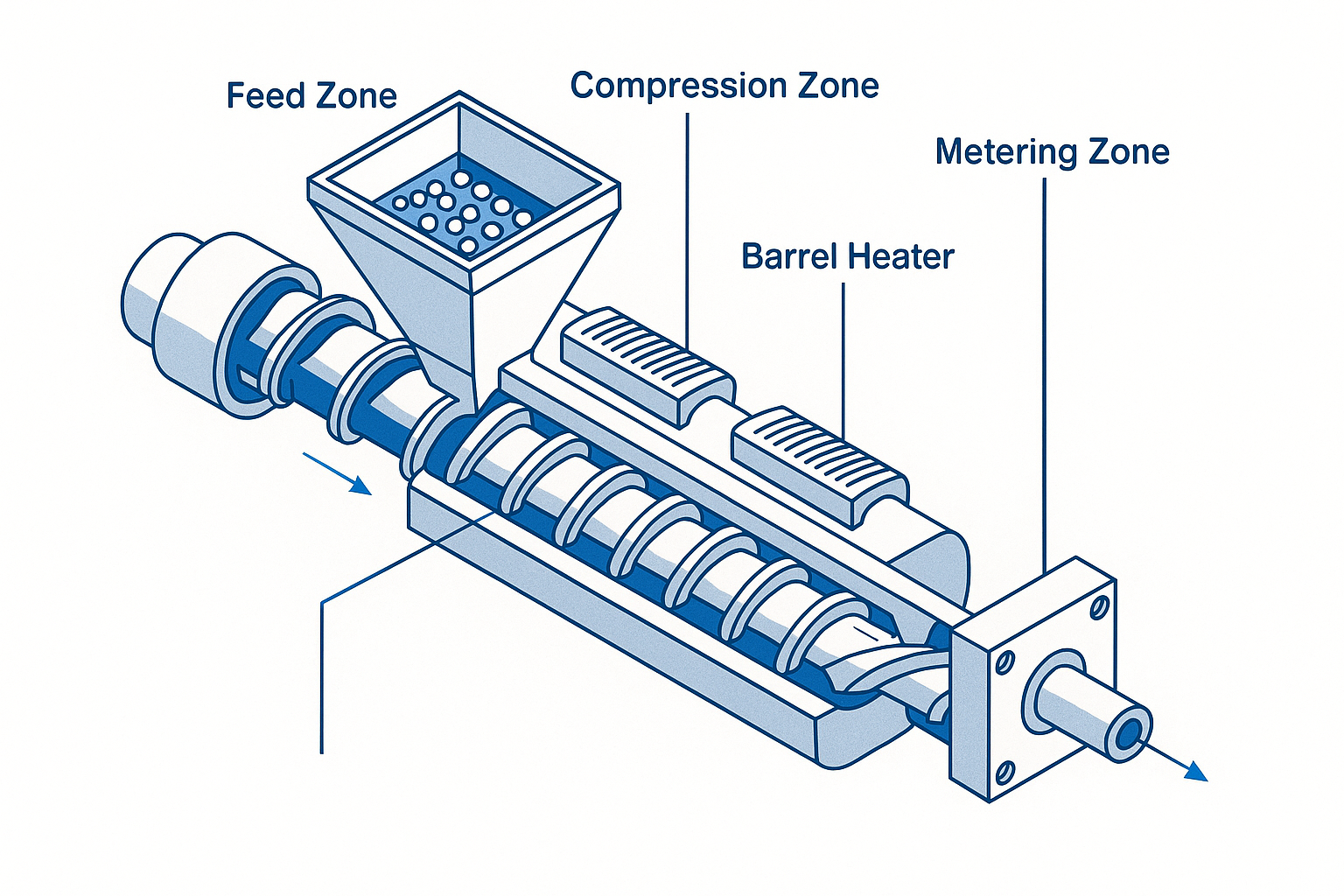
2. آلات البثق اللولبية المزدوجة: تحسين الخلط والجودة
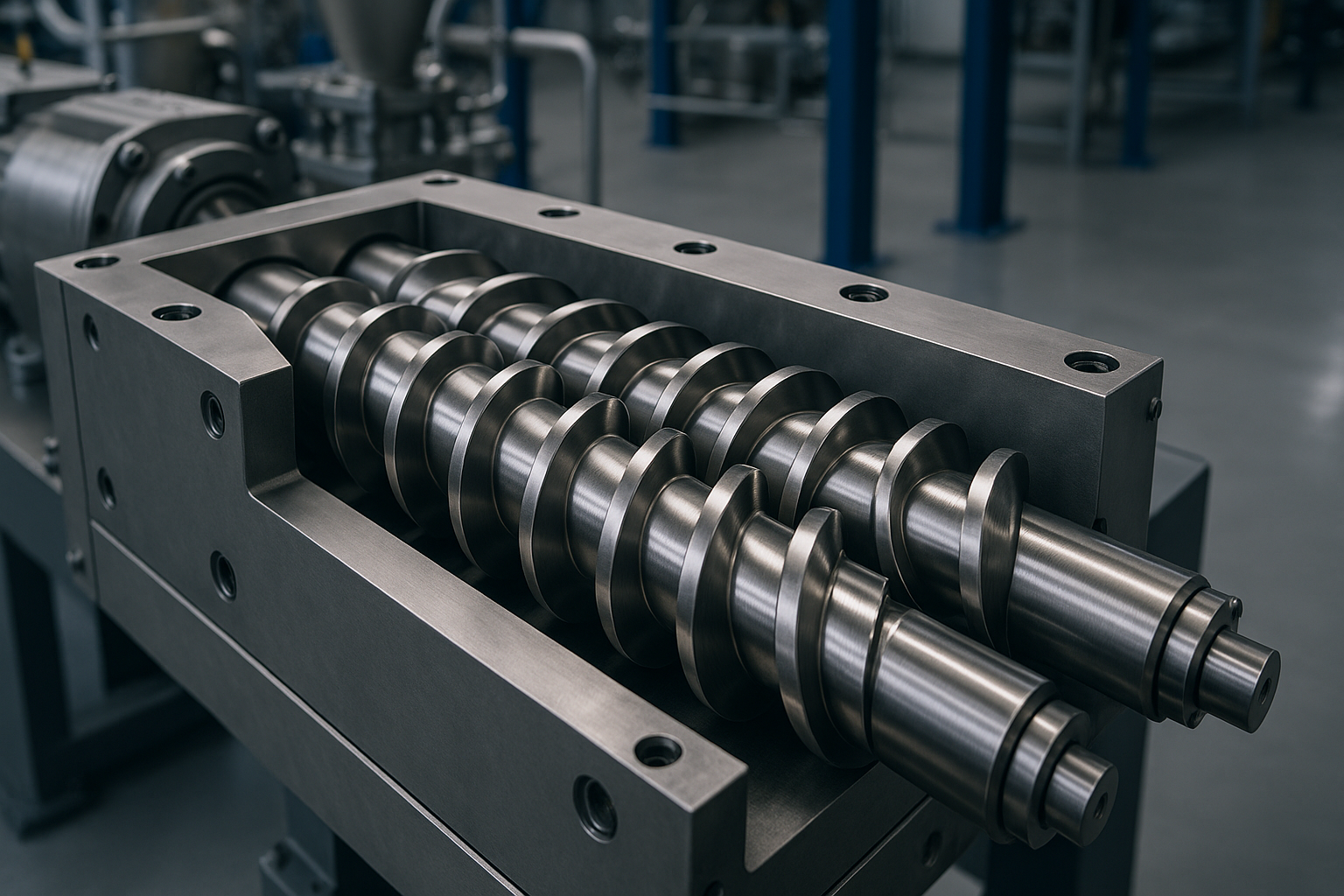
عندما تتطلب احتياجاتك الإنتاجية أكثر مما يمكن أن توفره التكنولوجيا أحادية اللولب من خلال آلة بثق ثنائية اللولب تصبح أفضل حلفائك. تمثل هذه الماكينات الرائعة التطور التالي في معدات بثق البلاستيكيتميز ببرغيين متشابكين يعملان معًا داخل البرميل. وهذا يخلق نمط تدفق رائع يحسن بشكل كبير من قدرات الخلط والتركيب والمعالجة الشاملة.
هنا في شركة جيان تاي لماكينات البلاستيك JianTai، لاحظنا شيئًا مثيرًا للاهتمام - المزيد والمزيد من العملاء يسألون عن أنظمتنا اللولبية المزدوجة. وهذا ليس مفاجئًا حقًا. تتفوق هذه الماكينات عندما تكون الدقة مهمة وعندما تتعامل مع مواد من شأنها أن تسبب صداعًا لآلات البثق القياسية. تعمل البراغي المزدوجة على إنشاء حركة مسح ذاتي تمنع المواد من أن تعلق وتتحلل - وهو أمر بالغ الأهمية عندما تتعامل مع البوليمرات التي لا تحب الحرارة الزائدة.
ستجد آلات البثق اللولبية المزدوجة في نوعين رئيسيين. آلات البثق اللولبية المزدوجة الدوارة المشتركة تدور كلا البرغيين في نفس الاتجاه، مما يخلق خصائص خلط ممتازة وتنظيف ذاتي ممتازة. هذه هي أحصنة العمل لعمليات التركيب ومعالجة البوليمر التقنية. ثم هناك آلات البثق اللولبية المزدوجة ذات الدوران المعاكسحيث تدور البراغي في اتجاهين متعاكسين. وهذا يخلق قوى قص قوية وتحكم قوي في الضغط، مما يجعلها مثالية لمعالجة الـ PVC والتطبيقات التي يكون فيها الضغط الدقيق مهمًا.
تُظهر سلسلة MD الخاصة بنا من آلات البثق ثنائية اللولب مدى التقدم الذي حققته هذه التكنولوجيا. مع أقطار لولبية تتراوح من Φ20 مم متواضعة تصل إلى Φ500 مم، وأطوال يمكن أن تمتد حتى 10000 مم، يمكننا تخصيص هذه الماكينات بدقة لتلبية احتياجات خط الإنتاج الخاص بك.
متى تختار معدات بثق البلاستيك ثنائية اللولب اللولبي
هل تتساءل عما إذا كان الطارد اللولبي المزدوج مناسبًا لعمليتك؟ هناك العديد من السيناريوهات التي يكون فيها الاستثمار في معدات بثق البلاستيك ثنائية اللولب منطقي تمامًا.
معالجة المواد الحساسة هو المكان الذي تتألق فيه هذه الماكينات حقًا. فبعض البوليمرات والمواد المضافة لا تتعامل مع التسخين لفترات طويلة بشكل جيد - فهي تتحلل وتتسبب في جميع أنواع المشاكل. توفر ماكينات البثق اللولبية المزدوجة وقت بقاء أكثر تحكمًا، مما يعني أن المواد الخاصة بك تقضي وقتًا أقل في التعرض للحرارة. ستشكرك موادك الحساسة للحرارة!
عندما يتعلق الأمر ب التركيب المركب المعقدلا شيء يضاهي الطارد اللولبي المزدوج. هل تحتاج إلى خلط البوليمرات بدقة مع المواد المضافة أو مواد الحشو أو مواد التعزيز أو الملونات؟ تضمن هذه الماكينات توزيع كل شيء بالتساوي في جميع المواد الخاصة بك. والنتيجة؟ خصائص منتج متناسقة دفعة بعد دفعة.
بالنسبة للمنتجات التي تحتوي على متطلبات جودة أعلىتوفر آلات البثق اللولبية المزدوجة نتائج فائقة. وتعني قدراتها المحسّنة في الخلط وإزالة الغازات تقليل العيوب وزيادة جودة الإنتاج. إذا كنت تنتج أجزاء تقنية ذات متطلبات صارمة، فإن هذه الميزة وحدها يمكن أن تبرر الاستثمار.
تتفوق آلات البثق اللولبية المزدوجة أيضًا في البثق التفاعلي - العمليات التي تحتاج إلى حدوث تفاعلات كيميائية أثناء البثق. فهي توفر الخلط الدقيق والتحكم الدقيق في وقت المكوث اللازم لتحقيق هذه التفاعلات بفعالية.
في عالم اليوم الذي يركز على الاستدامة, إعادة تدوير المواد القدرات مهمة أكثر من أي وقت مضى. تتعامل آلات البثق اللولبية المزدوجة مع المواد البلاستيكية المعاد تدويرها بشكل رائع، حتى عندما تحتوي تلك المواد على ملوثات أو ذات تركيبات مختلفة. وكما يقول أحد عملائنا الذين يعالجون نفايات ما بعد الاستهلاك: "يتعامل نظامنا ثنائي اللولب مع الاختلافات في المواد المعاد تدويرها التي من شأنها أن تعيق تمامًا إعدادنا القديم أحادي اللولب."
كما يقول تشانغ وي، مهندسنا الرئيسي الذي يتمتع بأكثر من عقدين من الخبرة في تخصيص معدات البثق، للعملاء في كثير من الأحيان: "تمنحك أجهزة البثق اللولبية المزدوجة تحكمًا دقيقًا في كل جانب من جوانب عملية البثق. عندما تعمل مع مواد صعبة أو تحتاج إلى جودة استثنائية، فإنها غالبًا ما تستحق الاستثمار الإضافي."
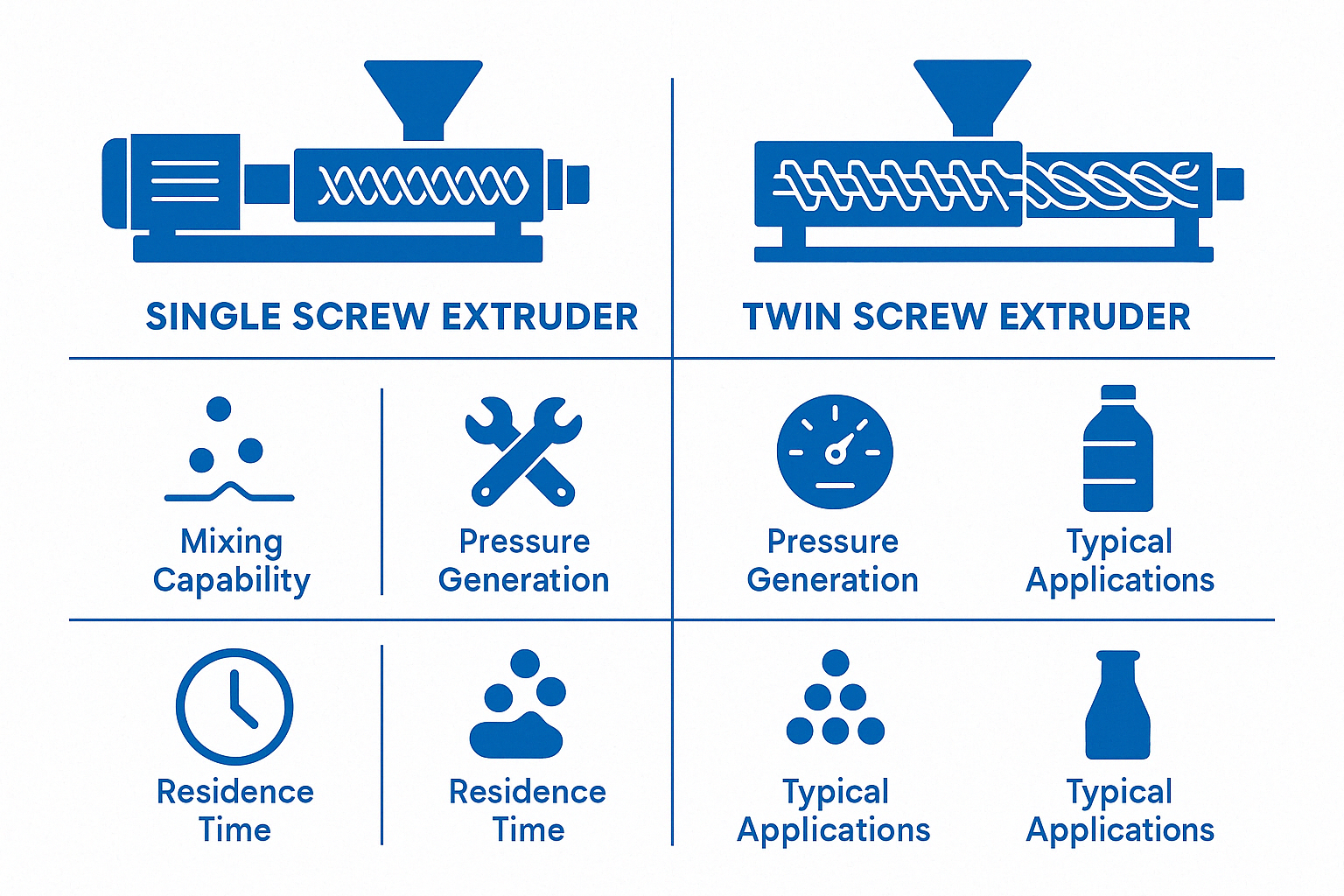
3. خطوط البثق القابلة للتخصيص لتلبية احتياجات الصناعة المحددة
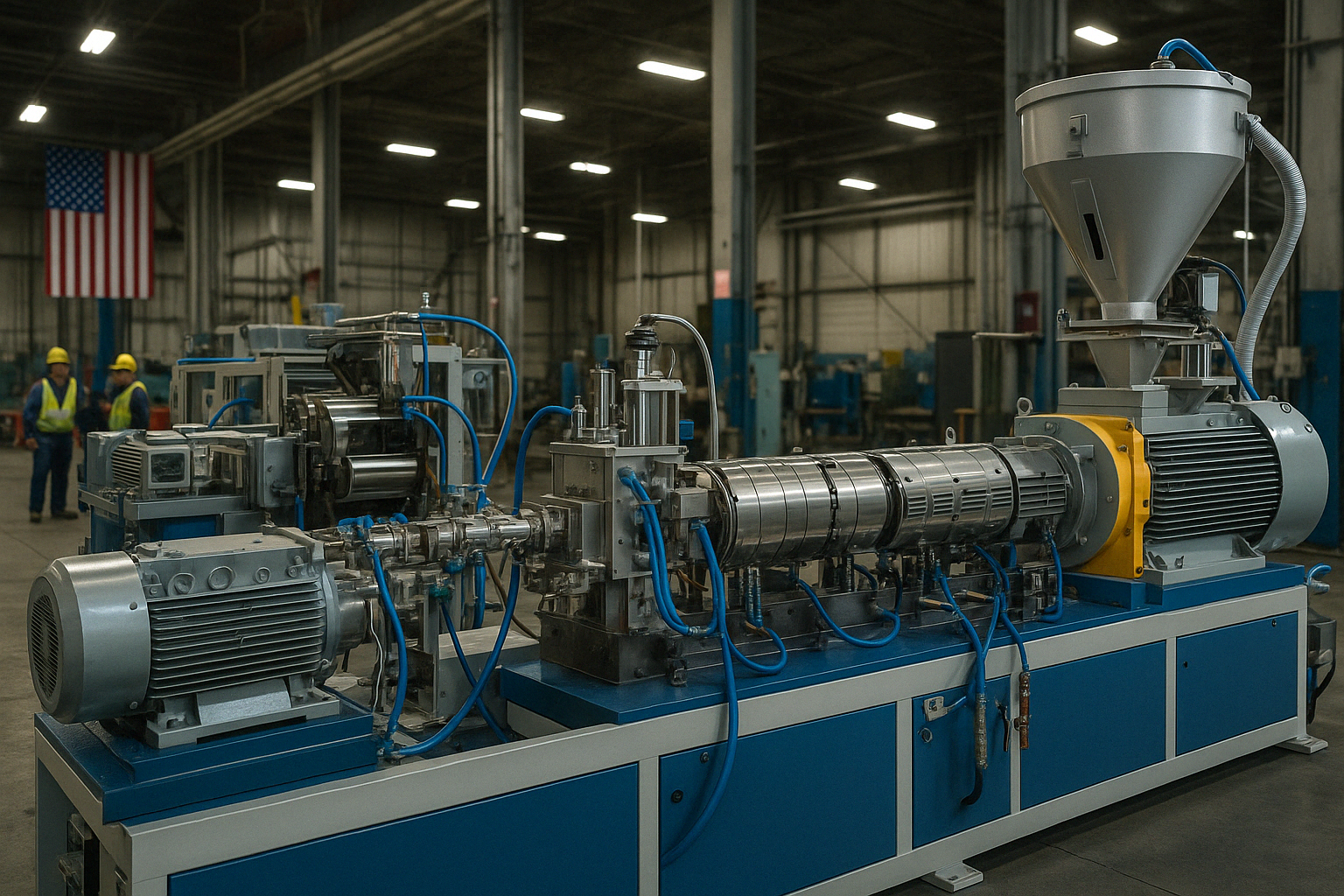
لا تواجه أي عمليتي تصنيع تحديات متطابقة - ولهذا السبب في شركة جيان تاي للماكينات البلاستيكية معدات بثق البلاستيك يجب أن تتكيف مع الاحتياجات المتنوعة على نطاق واسع. سواء كنت تنتج أنابيب طبية حساسة أو أنابيب زراعية قوية، يجب أن يكون خط الإنتاج الخاص بك فريدًا مثل منتجاتك.
يكمن جمال تقنية البثق الحديثة في قدرتها على التكيف. ضع في اعتبارك الشركة المصنعة التي تنتج إطارات النوافذ في ميشيغان مقابل الشركة التي تصنع أنابيب الري في أريزونا - كلاهما يستخدم عمليات البثق، ولكن لا يمكن أن تكون متطلبات المعدات الخاصة بهما أكثر اختلافًا. هذا التنوع هو السبب في أن التخصيص لم يعد مفيدًا فحسب، بل أصبح ضروريًا.
مع وجود أكثر من 75 عامًا في الصناعة، وجد المبتكرون أن تخصيص المعدات لتطبيقات محددة يؤثر بشكل مباشر على كل من الجودة والإنتاج. عندما نقوم بتخصيص تصميم لولبي لبوليمر معين، فإننا لا نغير مكونًا واحدًا فقط - بل نقوم بتحسين عملية الإنتاج بالكامل. قد تعمل هندسة اللولب المطابقة تمامًا على تحسين كفاءة الصهر لديك بنسبة 15-20% مع تقليل استهلاك الطاقة وتعزيز اتساق المنتج.
تمثل تكوينات البرميل نقطة تخصيص حاسمة أخرى. بالنسبة للمواد التي تطلق الغازات أثناء المعالجة، تمنع منافذ التفريغ الاستراتيجية تكوين الفقاعات وعيوب المنتج. وبالمثل، تضمن تصميمات القوالب المخصصة أن يحقق منتجك النهائي الأبعاد الدقيقة والتشطيب السطحي الذي يتوقعه عملاؤك.
تضيف أنظمة التحكم الحديثة طبقة أخرى من التخصيص. يمكن برمجة آلات البثق الذكية اليوم بمعلمات معالجة خاصة بالمواد التي يتم ضبطها تلقائيًا عند تغير الظروف، مما يحافظ على جودة ثابتة حتى عند مواجهة متغيرات مثل الرطوبة أو تغيرات المواد الخام.
بالنسبة للتطبيقات المتخصصة مثل مقاطع PVC الصلبة المستخدمة في البناء، تصبح هذه التخصيصات أكثر أهمية. لدينا معدات بثق مقاطع البولي فينيل كلوريد الفينيل الصلبة تشتمل على ميزات محددة تعالج التحديات الفريدة لمعالجة ال PVC، بما في ذلك التحكم الدقيق في درجة الحرارة لمنع التدهور وأنظمة التبريد المتخصصة التي تقلل من التواء.
المكونات الرئيسية لخطوط معدات بثق البلاستيك
يقف وراء كل عملية بثق ناجحة نظام متناغم من المكونات التي تعمل معًا. يساعدك فهم كيفية تفاعل هذه العناصر على بناء النظام المثالي لاحتياجاتك الخاصة.
إن الطارد بمثابة قلب خط الإنتاج، حيث يتحول البلاستيك الخام إلى ذوبان متجانس. ويعتمد أداؤها على عوامل مثل تصميم البرغي ونسبة الطول إلى القطر وقوة الدفع. بالنسبة للمواد الكاشطة، قد نوصي باستخدام بطانات أسطوانية مقاومة للتآكل تطيل عمر المعدات من أشهر إلى سنوات.
يأتي بعد ذلك رأس القالبالذي يعطي منتجك شكله. يُعد تصميم القالب علمًا وفنًا في آنٍ واحد - ويعني الحصول عليه بشكل صحيح تحقيق التدفق المثالي للمواد مع الحفاظ على الأبعاد الدقيقة. يقلل القالب المصمم بشكل جيد من متطلبات الضغط ويحسن من تشطيب السطح، مما يعزز جودة المنتج بشكل مباشر.
إن نظام التبريد قد يبدو الأمر بسيطًا، ولكنه في الواقع مصدر العديد من مشكلات الجودة. يتسبب التبريد غير المتكافئ في حدوث اعوجاج وتناقضات في الأبعاد. بالنسبة للمنتجات رقيقة الجدران، غالبًا ما نوصي بالتبريد متعدد المراحل الذي يقلل درجة الحرارة تدريجيًا، مما يمنع الضغوط الداخلية التي تؤدي إلى فشل المنتج.
أنت تحجيم المعدات يضمن احتفاظ المنتج بالأبعاد الصحيحة أثناء تبريده. يمكن تصميم أنظمة المعايرة بالتفريغ حسب الطلب لملامح محددة، مع الحفاظ على تفاوتات دقيقة حتى بالنسبة للأشكال المعقدة.
إن مجتذب تسحب البثق من القالب بمعدلات مضبوطة بدقة. تتميز أدوات السحب الحديثة بالمزامنة مع الطارد، حيث يتم ضبطها تلقائيًا للحفاظ على اتساق الأبعاد حتى عندما تتقلب ظروف المعالجة.
بالنسبة للمنتجات النهائية, القواطع و معدات الإقلاع إكمال خط الإنتاج الخاص بك. توفر القواطع عالية الدقة قطعًا نظيفًا بأطوال دقيقة، بينما تقوم أنظمة المناولة المتخصصة بتكديس منتجاتك أو لفها أو تغليفها وفقًا لمتطلباتك الخاصة.
يشرح أحد المتخصصين في هذا المجال الذي يتمتع بخبرة تزيد عن 20 عامًا من الخبرة في التخصيص ذلك على أفضل وجه: "إن خط البثق المحسّن حقًا ليس مجرد مجموعة من المكونات، بل هو نظام متكامل حيث يكمل كل عنصر العناصر الأخرى." يوفر هذا النهج الشامل الاتساق الذي يحتاجه المصنعون دفعة بعد دفعة.
في JianTai، وجدنا أن المكونات القابلة للتعديل تُحدث فرقًا كبيرًا في تلبية احتياجات الصناعة المحددة. وسواء كنت تعالج المواد البكر أو المواد القابلة لإعادة التدوير، وتنتج أشكالًا بسيطة أو معقدة، فإن خط البثق المخصص بعناية يحول المواد الصعبة إلى منتجات مربحة.
4. معدات متطورة في المرحلة النهائية لتحسين عملية البثق
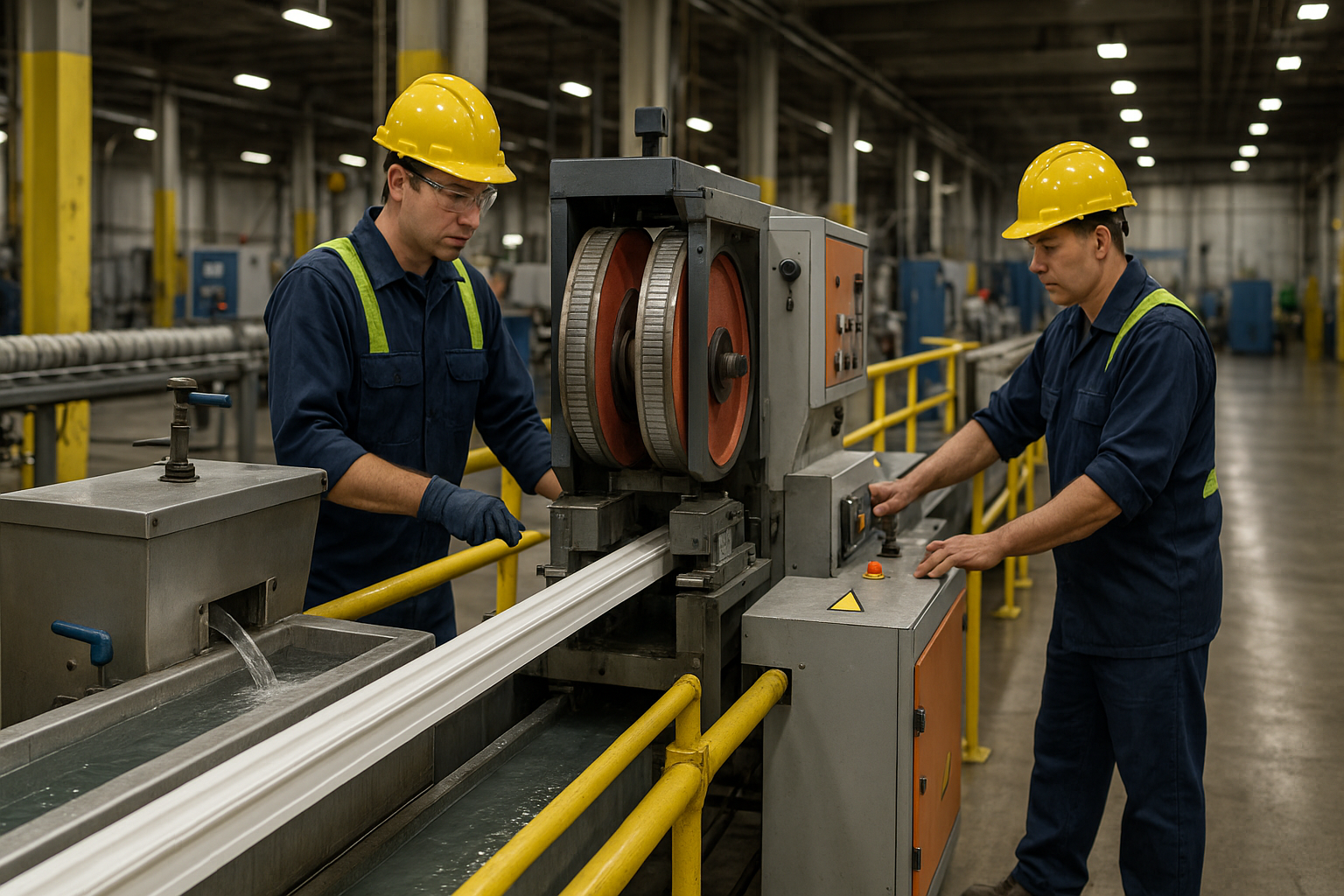
عندما نتحدث عن بثق البلاستيك، من السهل أن نركز كل اهتمامنا على الطارد نفسه. ومع ذلك، فقد تعلمنا في شركة جيان تاي لماكينات البلاستيك من خلال سنوات من الخبرة أن ما يحدث بعد خروج البلاستيك من القالب لا يقل أهمية عن جودة المنتج النهائي. وهنا يأتي دور المعدات النهائية - الأبطال المجهولون في عملية البثق.
فكّر في المعدات النهائية على أنها فريق العمل الداعم الذي يضمن تألق نجم أدائك (الطارد). فبدون مزامنة المكونات النهائية بشكل صحيح، حتى الطارد الأكثر تقدمًا في العالم سيواجه صعوبة في إنتاج منتجات متسقة وعالية الجودة.
إن رحلة منتجك البلاستيكي لا تنتهي عند القالب - إنها مجرد بداية. فبينما يخرج البلاستيك الساخن القابل للطرق من القالب، فإنه يحتاج إلى معالجة مناسبة ليصبح المنتج النهائي الذي تتخيله. صهاريج التبريد ومعدات التحجيم يتولى الأمر على الفور، باستخدام الماء أو الهواء الذي يتم التحكم فيه بعناية لتجميد منتجك مع الحفاظ على الأبعاد الدقيقة. تتميز خزاناتنا المتقدمة بأنظمة تحكم في درجة الحرارة يمكن ضبطها في حدود 1 درجة مئوية، مما يضمن تبريد منتجاتك بالمعدل الأمثل.
بمجرد تبريده وتغيير حجمه، ينتقل المنتج إلى ساحبات الأحزمة - ربما أكثر نقاط المزامنة أهمية في الخط بأكمله. تحافظ هذه الأجهزة على الشد والسرعة المثالية، مع أدوات تحكم رقمية حديثة تحقق دقة في حدود ± 0.1%. وكما أخبرنا أحد عملائنا مؤخرًا، "لقد أدى الاتساق الذي نحصل عليه من ماكينات السحب من JianTai إلى تقليل التباين في الأبعاد لدينا بما يقرب من 50%."
بالنسبة للمنتجات التي تحتاج إلى قصها بأطوال محددة، فإن قواطع تعمل بمحرك مؤازر توفر دقة مذهلة بسرعات تتراوح من 200 إلى 1,000 عملية قطع في الدقيقة. لقد صممنا أنظمة القطع الخاصة بنا بميزات التبديل السريع للشفرات التي يمكن أن تقلل من وقت التبديل من ساعات إلى دقائق - وهي تفاصيل صغيرة تحدث فرقًا كبيرًا في جدول الإنتاج الخاص بك.
تستفيد بعض التطبيقات من وحدات السحب/القطّاعة المركبة التي توفر مساحة أرضية قيمة مع تحسين التزامن في الوقت نفسه. هذه الأنظمة المتكاملة ذات قيمة خاصة للمنشآت الأصغر أو عند العمل مع المواد الصعبة التي تتطلب تحكمًا دقيقًا في الشد أثناء القطع.
بالنسبة للمنتجات المرنة مثل الأنابيب أو الكابلات ماكينات اللف قم بلف منتجك تلقائيًا على البكرات بشد ثابت - وهي مهمة يستحيل تقريبًا تحقيقها يدويًا بأي اتساق. وفي نهاية الخط ناقلات السحب وطاولات التفريغ ضمان التعامل مع منتجاتك النهائية برفق وكفاءة.
تعزيز الكفاءة باستخدام معدات المصب
لا تعمل المعدات المناسبة في المراحل النهائية على تحسين جودة المنتج فحسب، بل إنها تُحدث تحولاً في العملية بأكملها. عندما نعمل مع العملاء لتحسين معدات بثق البلاستيك، نركز على عدة فوائد رئيسية:
تحسين الجودة تأتي من الدقة في كل خطوة. عندما يكون التبريد متناسقًا والقطع نظيفًا، فإن منتجاتك ببساطة تبدو وأداءها أفضل. وقد أفاد أحد عملائنا في صناعة الأنابيب الطبية أنه بعد ترقية معدات التجهيز النهائي، تحسّن الامتثال للتحمل من 92% إلى 99.2% - وهو فرق مهم للغاية في التطبيقات الحرجة.
مكاسب الإنتاجية غالبًا ما تفاجئ عملاءنا. من خلال القضاء على الاختناقات في العملية النهائية، يمكن لخط الإنتاج بأكمله أن يعمل بالسرعة المثلى. تعمل أنظمة المناولة المؤتمتة الحديثة على تقليل متطلبات العمالة مع زيادة الإنتاجية - أحيانًا بما يصل إلى 30-40% مقارنةً بالأنظمة القديمة.
كفاءة الطاقة أصبحت ذات أهمية متزايدة، وتعالج المعدات النهائية الحديثة هذه الحاجة. يمكن لمحركات التردد المتغير، وخزانات التبريد المعزولة، والحجم الأمثل للمحرك أن تقلل من استهلاك الطاقة بنسبة 10-151 تيرابايت 3 تيرابايت مقارنةً بالجيل السابق من المعدات. تتراكم هذه الوفورات بسرعة، وغالبًا ما يتم دفع تكاليف تحديث المعدات في غضون سنوات قليلة فقط.
إن المرونة من المعدات النهائية اليوم رائعة. تتيح لك أدوات التحكم الرقمية وميزات التغيير السريع تبديل المنتجات في دقائق بدلاً من ساعات. وهذا يعني أنه يمكنك تشغيل دفعات أصغر بشكل مربح والاستجابة بسرعة لطلبات العملاء - وهي ميزة تنافسية في السوق اليوم.
ربما الأهم من ذلك أن المعدات النهائية المصممة بشكل جيد في المصب بشكل كبير تقليل النفايات. تقلل أنظمة التحكم الدقيقة من خردة بدء التشغيل وتحافظ على جودة ثابتة طوال عمليات الإنتاج. وفي عصر ارتفاع تكاليف المواد والوعي البيئي، يمكن لهذه الميزة وحدها أن تبرر الاستثمار في معدات التجهيز النهائي عالية الجودة.
التكامل هو المفتاح لجعل جميع هذه المكونات تعمل معًا بسلاسة. وتتميز خطوط البثق الحديثة بأنظمة تحكم مركزية تعمل على مزامنة كل مكون، وتعديل السرعات والمعلمات تلقائيًا للحفاظ على ظروف الإنتاج المثلى. عندما تزيد سرعة الطارد، يستجيب كل مكوّن من مكونات المصب بتناغم تام - مما يحافظ على جودة المنتج ويقلل من الهدر.
كما نقول كثيرًا لعملائنا في JianTai: "خط البثق لا يكون قويًا إلا بقدر قوة أضعف مكوناته." من خلال الاستثمار في معدات المصب عالية الجودة التي تتوافق مع قدرات الطارد الخاص بك، فإنك تضمن أن كل جزء من عملية الإنتاج الخاصة بك يساهم في نجاحك. والنتيجة؟ منتجات أفضل، وعملاء أكثر سعادة، وأرباح أكثر صحة.
5. أحدث التطورات التكنولوجية في ماكينات بثق البلاستيك

تجول في أي منشأة حديثة لتصنيع البلاستيك اليوم، وستجد أنها بعيدة كل البعد عن المصانع التي كانت موجودة في المصانع حتى قبل عقد من الزمن. عالم معدات بثق البلاستيك تحوّلت بشكل كبير، مع الابتكارات التي تجعل آلات الأمس تبدو وكأنها من بقايا عصر آخر.
لقد شهدنا في شركة جيان تاي للماكينات البلاستيكية هذا التطور بشكل مباشر، حيث نبقى في الطليعة لضمان استفادة عملائنا من كل قفزة تكنولوجية إلى الأمام. هذه التطورات ليست فقط مثيرة للإعجاب على الورق - فهي تغير الاقتصاد والأثر البيئي لتصنيع البلاستيك بطرق عميقة.
خذ كفاءة الطاقة، على سبيل المثال. تشتمل آلات البثق الحديثة الآن على أنظمة الدفع المباشر التي تستبعد علب التروس التقليدية تمامًا. هذا التغيير الذي يبدو بسيطًا يقلل من فقدان الطاقة، ويقلل من مشاكل الصيانة، ويمكن أن يقلل من استهلاك الطاقة بنسبة 10-15%. بالنسبة للتشغيل على مدار الساعة طوال أيام الأسبوع، فإن هذه الوفورات تتراكم بسرعة على كل من فواتير المرافق وبصمة الكربون.
توسعت المواد التي يمكنك معالجتها بشكل كبير أيضًا. فتحت التصميمات الجديدة للبراغي والأسطوانات القدرة على العمل مع كل شيء بدءًا من البوليمرات الهندسية عالية الحرارة إلى أحدث أنواع البلاستيك الحيوي. والأكثر إثارة بالنسبة للمصنعين المهتمين بالاستدامة هو القدرة على معالجة ما يصل إلى 100% من المواد المعاد تدويرها - بما في ذلك رقائق PET و rHDPE - دون التضحية بالجودة أو الكفاءة.
ويوضح أحد كبار المهندسين لدينا قائلاً: "قبل خمس سنوات، كان تشغيل نسب عالية من المحتوى المعاد تدويره يعني قبول تباطؤ كبير في الإنتاج". "لقد غيرت معدات اليوم هذه المعادلة تمامًا. يمكنك أن تكون صديقًا للبيئة ومربحًا في الوقت نفسه."
لقد أصبحت العقول الكامنة وراء هذه الآلات أكثر ذكاءً بشكل ملحوظ أيضًا. لا تكتفي أنظمة التحكم الحديثة بمراقبة العملية فحسب، بل إنها تتوقع المشاكل وتمنع حدوثها قبل أن تؤثر على منتجك. تحدث التعديلات في الوقت الحقيقي تلقائيًا، مما يحافظ على الاتساق التام حتى عندما تختلف مواد الإدخال. حتى أن بعض الأنظمة تتضمن ذكاءً اصطناعيًا لتحسين معلمات العملية باستمرار، وإيجاد الكفاءات التي قد يفوتها المشغلون البشريون.
أصبحت الصيانة أبسط أيضًا، وذلك بفضل التصميمات المعيارية التي تسمح بالتبديل السريع للمكونات. عندما يحتاج أحد الأجزاء إلى الاستبدال أو عندما تريد التهيئة لتطبيق مختلف، يتم تقليل وقت التوقف عن العمل إلى الحد الأدنى. وتعني هذه النمطية أيضاً أن استثمارك أكثر قدرة على الصمود في المستقبل، حيث يمكن ترقية المكونات الفردية مع تقدم التكنولوجيا.
الابتكارات التي تشكل مستقبل صناعة البثق
تتجاوز التغييرات الحقيقية في هذه الصناعة التحسينات الإضافية لتعيد تشكيل كيفية عمل خطوط البثق بشكل أساسي وتتكامل مع منظومة التصنيع الأوسع نطاقاً.
الأتمتة وتكامل الصناعة 4.0 ربما يكون التأثير الأكثر وضوحًا على العمليات اليومية. فالخطوط الحديثة تتعامل مع كل شيء بدءًا من تغذية المواد إلى التغليف النهائي بأقل قدر من التدخل البشري. والأهم من ذلك أنها تتواصل بسلاسة مع أنظمة إدارة المصنع، مما يوفر بيانات في الوقت الفعلي عن معدلات الإنتاج ومقاييس الجودة واستخدام الموارد. يعمل هذا الاتصال على تغيير طريقة إدارتك لعملياتك، مما يتيح لك اتخاذ قرارات تعتمد على البيانات التي تعزز الجودة والكفاءة.
إن واجهات المستخدم من معدات اليوم لا يمكن التعرف عليها للمشغلين من الأجيال السابقة. حلت الشاشات البديهية التي تعمل باللمس ذات الرسومات الواضحة محل لوحات التحكم المعقدة، مما قلل من وقت التدريب وأخطاء المشغل. والأكثر من ذلك هو القدرة على مراقبة خط الإنتاج وضبطه عن بُعد. عند ظهور المشاكل، يمكن للخبراء استكشاف الأخطاء وإصلاحها من أي مكان في العالم، وغالبًا ما يتم حل المشاكل دون أن تطأ قدمك منشأتك.
على صعيد الاستدامة، تتواصل الابتكارات بوتيرة سريعة. أنظمة استعادة الطاقة تلتقط الآن الحرارة التي كانت تهدر في السابق وتعيد توظيفها. تعمل محركات التردد المتغير على ضبط سرعات المحركات لتتناسب مع احتياجات الإنتاج الفعلية بدلاً من تشغيلها بكامل طاقتها بشكل مستمر. حتى أن بعض المصنعين يدمجون أنظمة التسخين بالحث التي توفر تحكمًا أكثر دقة في درجة الحرارة مع تقليل استهلاك الطاقة بشكل أكبر.
ولعل أكثر ما يثير الاهتمام هو المعدات المصممة خصيصاً لـ الاقتصاد الدائري. يمكن لأنظمة الترشيح المتقدمة الآن إزالة الملوثات من المواد المعاد تدويرها والتي كانت ستجعلها غير صالحة للاستخدام في السابق. تسمح تكنولوجيا البثق المشترك بالاستخدام الاستراتيجي للمحتوى المعاد تدويره في الطبقات غير الحرجة، مما يزيد من استخدام الموارد مع الحفاظ على أداء المنتج.
"تشهد صناعة البثق ثورة تكنولوجية"، كما يقول أحد المخضرمين المخضرمين الذي قضى أكثر من 20 عامًا في هذا المجال. "إن معدات اليوم لا تنتج منتجات عالية الجودة بكفاءة أكبر فحسب، بل تتصدى أيضًا لتحديات الاستدامة الحرجة من خلال تمكين المعالجة الفعالة للمواد المعاد تدويرها."
نحن في شركة جيان تاي للماكينات البلاستيكية لا نتبع هذه الاتجاهات فحسب، بل نساعد في ابتكارها. يضمن التزامنا بالتقدم التكنولوجي أن يظل عملاؤنا في المقدمة في سوق تتزايد فيه المنافسة والوعي البيئي. ومن خلال دمج هذه الابتكارات في تصميمات معداتنا، فإننا نقدم حلولاً تلبي احتياجات الإنتاج الفورية وأهداف الاستدامة طويلة الأجل.
للمزيد من المعلومات حول كيفية تطبيق هذه التطورات التكنولوجية في هذا المجال، يمكنك زيارة موقع تكنولوجيا البلاستيك مركز الموارد، الذي يوفر تغطية متعمقة لابتكارات البثق.
لا تشبه معدات بثق البلاستيك اليوم معدات البثق البلاستيكية إلا قليلاً عن سابقاتها، وتعد ابتكارات الغد بتطورات أكبر. بالنسبة للمصنعين الذين يتطلعون إلى الحفاظ على قدرتهم التنافسية، فإن فهم هذه التطورات التكنولوجية وتبنيها ليس مفيدًا فحسب - بل ضروريًا.
الأسئلة المتداولة حول معدات بثق البلاستيك
ما هي المواد التي يمكن استخدامها في بثق البلاستيك؟
عندما يتواصل معنا المصنعون في شركة جيان تاي للماكينات البلاستيكية بشأن معدات بثق البلاستيكغالبًا ما يكون أحد أسئلتهم الأولى حول توافق المواد. يكمن جمال بثق البلاستيك في تعدد استخداماته عبر مجموعة واسعة من اللدائن الحرارية، على الرغم من أن كل مادة تجلب متطلبات المعالجة الفريدة الخاصة بها.
البولي إيثيلين (PE) تظل واحدة من أكثر المواد المعالجة شيوعًا في أجهزة البثق لدينا. يتوفر البولي إيثيلين بكثافات مختلفة مثل البولي إثيلين منخفض الكثافة والبولي إثيلين عالي الكثافة والبولي إثيلين عالي الكثافة والبولي إثيلين منخفض الكثافة، وهو متسامح بشكل رائع أثناء المعالجة. فهو يتدفق بشكل جيد في درجات حرارة منخفضة نسبيًا تتراوح بين 160-240 درجة مئوية، مما يجعله مثاليًا لكل شيء بدءًا من أنابيب المياه وحتى أكياس التسوق.
البولي بروبلين (PP) يتطلب مزيدًا من الاهتمام أثناء المعالجة. وبفضل نافذة المعالجة الأضيق (200-270 درجة مئوية عادةً)، فإنها تتطلب تحكمًا أكثر دقة في درجة الحرارة. ومع ذلك، فإن العناية الإضافية تؤتي ثمارها في شكل مكونات متينة للسيارات، وتغليف قوي، وحتى منسوجات ذات مقاومة ممتازة للمواد الكيميائية.
يعمل العديد من عملائنا على نطاق واسع مع كلوريد البوليفينيل المتعدد الفينيل (PVC)خاصةً في تطبيقات البناء. يمكن أن يكون PVC متقلب المزاج بعض الشيء - فمعالجته ساخنًا جدًا وسيتحلل، مما قد يؤدي إلى إطلاق منتجات ثانوية مسببة للتآكل. نوصي عادةً بمواد أسطوانية متخصصة والتحكم الدقيق في درجة الحرارة في نطاق 160-200 درجة مئوية للحفاظ على PVC أثناء البثق.
للتغليف والمنتجات الاستهلاكية, البوليسترين (PS) يوفر وضوحًا وصلابة ممتازين. وتتطلب المعالجة بين 180-280 درجة مئوية، وتتطلب تحكمًا جيدًا في درجة الحرارة لمنع التدهور الذي يمكن أن يؤثر على المظهر والخصائص.
عندما تكون مقاومة الصدمات والتشطيبات السطحية القوية مهمة, أكريلونيتريل بوتادين ستايرين (ABS) يلمع. تتم معالجة هذا البلاستيك الهندسي عند درجة حرارة تتراوح بين 200 و260 درجة مئوية، وقد أصبح عنصرًا أساسيًا في مكونات السيارات والإلكترونيات الاستهلاكية.
بولي إيثيلين تيريفثالات البولي إيثيلين (PET) يمثل تحديات فريدة من نوعها تم تصميم آلات البثق الأكثر تقدمًا لدينا للتعامل معها. تُستخدم PET في المقام الأول في الزجاجات والألياف، ويجب تجفيفها تمامًا قبل المعالجة لمنع التحلل المائي. وتجعل درجات حرارة المعالجة المرتفعة (260-300 درجة مئوية) وحساسيتها للرطوبة من المعدات المتخصصة استثمارًا حكيمًا.
نحن نشهد اهتمامًا متزايدًا بـ البلاستيك القابل للتحلل الحيوي مثل PLA و PBAT وPBS. غالبًا ما تتطلب هذه المواد ظروف معالجة محددة وتصميمات لولبية معينة، ولكن الفوائد البيئية تجعل الاهتمام الإضافي جديرًا بالاهتمام.
ولعل الأكثر إثارة هو التركيز المتزايد على البلاستيك المعاد تدويره. وعلى الرغم من أن هذه المواد تمثل تحديات بسبب التلوث المحتمل والخصائص المتغيرة، فإن أنظمة الترشيح المتقدمة والتصميمات اللولبية القوية التي نقدمها تساعد الشركات المصنعة على دمج المحتوى المعاد تدويره بنجاح في منتجاتها.
وكما يقول أحد مهندسينا: "لا يكمن سر نجاح البثق الناجح في امتلاك معدات جيدة فحسب - بل في امتلاك المعدات المناسبة لمادتك المحددة. فما يصلح للبولي إيثيلين قد يكون خاطئًا تمامًا لمادة البولي إيثيلين PET."
كيف يؤثر اختيار معدات البثق على جودة المنتج؟
اختيار معدات بثق البلاستيك يؤثر على كل جانب من جوانب جودة المنتج النهائي تقريبًا. هذه العلاقة بين المعدات وجودة المخرجات هي شيء نأخذه على محمل الجد في JianTai.
دقة الأبعاد ربما يكون عامل الجودة الأكثر وضوحًا. تحدد دقة جهاز البثق والقالب والمعدات النهائية بشكل مباشر ما إذا كانت منتجاتك تفي بالمواصفات أم لا. لقد رأينا الشركات المصنعة تعاني من عدم اتساق سُمك الجدار في الأنابيب أو الملامح غير المنتظمة لمجرد أن معداتها تفتقر إلى أنظمة التحكم اللازمة للحفاظ على معدلات إنتاج ودرجات حرارة ثابتة.
منتجك تشطيب السطح يحكي قصة عملية البثق الخاصة بك. ينتج القالب المصمم بشكل صحيح مع مسارات تدفق متساوية أسطحًا ناعمة ومتسقة، في حين أن مشاكل مثل قشرة القرش أو قشرة البرتقال غالبًا ما تشير إلى مشاكل في التحكم في درجة الحرارة. حتى طريقة التبريد الخاصة بك مهمة - سريعة للغاية وسترى علامات الإجهاد، وغير متساوية للغاية ويصبح الالتواء أمرًا حتميًا.
أقل ظهوراً للعيان ولكن بنفس القدر من الأهمية الخواص الميكانيكية لمنتجاتك المبثوقة. تؤثر ظروف المعالجة التي تنشئها معداتك تأثيرًا مباشرًا على الاتجاه الجزيئي والتبلور داخل البوليمر. تحدد هذه البنية المجهرية القوة والمرونة ومقاومة الصدمات. تضمن المعالجة المتسقة خصائص موحدة في جميع أنحاء منتجك - وهو أمر بالغ الأهمية بشكل خاص للتطبيقات التي لا يكون فيها الفشل خيارًا.
بالنسبة للمنتجات الشفافة، تصبح جودة المعدات واضحة على الفور. مناسبة الخواص البصرية تعتمد على الذوبان المتناسق والمعالجة الخالية من التلوث والتبريد المناسب - وكلها عوامل يحددها تصميم خط البثق الخاص بك.
يتغاضى العديد من المصنعين عن كيفية تأثير اختيار المعدات على الأداء على المدى الطويل. يمكن لظروف المعالجة أن تؤثر بشكل كبير على مقاومة التشقق الإجهادي البيئي وثبات الأشعة فوق البنفسجية وخصائص التقادم. تعمل قدرات التفريغ المناسبة على إزالة المكونات المتطايرة التي قد تسبب فقاعات أو فراغات قد تؤثر على الأداء بمرور الوقت.
ربما يكون الأكثر قيمة لمديري الإنتاج هو الاتساق من دفعة إلى أخرى التي تأتي مع المعدات المتطورة. تضمن أنظمة التحكم الحديثة أن تظل ظروف المعالجة مستقرة بمرور الوقت، مما يؤدي إلى جودة موحدة عبر عمليات الإنتاج. هذا الاتساق مهم بشكل خاص للتطبيقات الحرجة في القطاعات الطبية أو السيارات أو الإنشاءات حيث لا تترك المواصفات مجالًا كبيرًا للاختلاف.
يقول أحد عملائنا الذي يعمل منذ أكثر من عقدين في مجال بثق المقاطع الجانبية: "تعكس جودة منتجك النهائي بشكل مباشر جودة معدات البثق الخاصة بك". "فالاستثمار في المعدات المناسبة يؤتي ثماره عدة مرات من خلال تقليل الخردة وتقليل شكاوى العملاء وتعزيز سمعة الجودة."
ما هي اعتبارات الصيانة لمعدات البثق؟
الصيانة المناسبة هي البطل المجهول لعمليات بثق البلاستيك الناجحة. في شركة جيان تاي لماكينات البلاستيك، نؤكد في شركة جيان تاي لماكينات البلاستيك أنه حتى أفضل معدات بثق البلاستيك يتطلب عناية مدروسة ومنتظمة لتوفير أداء متناسق وطول العمر الافتراضي.
التنظيف المنتظم يشكل أساس أي برنامج صيانة. بمرور الوقت، يمكن أن تتحلل بقايا البوليمر بمرور الوقت، مما يؤدي إلى التلوث والتلف المحتمل للمعدات. نوصي بتنظيف مجموعات البراغي والبراميل أثناء تغيير المواد أو الألوان وعلى فترات زمنية محددة. وقد وجد العديد من عملائنا أن مركبات التطهير المتخصصة تجعل هذه العملية أكثر كفاءة بكثير من طرق التنظيف اليدوي.
مراقبة التآكل يساعد على اكتشاف المشاكل قبل أن تؤثر على جودة منتجك. المكونات الحرجة مثل البراغي والبراميل والقوالب تتعرض بطبيعة الحال للتآكل بمرور الوقت، خاصةً عند معالجة المواد الكاشطة. يساعد الفحص والقياس المنتظم في تحديد متى يصبح الاستبدال ضروريًا. تشتمل بعض معداتنا الأكثر تقدمًا على مراقبة التآكل الآلية لتبسيط هذه العملية.
أنت أنظمة التحكم في درجة الحرارة تستحق اهتمامًا خاصًا. تتطلب عناصر التسخين والمزدوجات الحرارية وأنظمة التبريد فحصًا ومعايرة منتظمة لضمان التحكم الدقيق في درجة الحرارة. يمكن أن تتسبب منطقة تسخين واحدة معطلة في حدوث مشكلات في المعالجة وعيوب في المنتج قد لا تكون واضحة على الفور ولكنها ستؤثر بالتأكيد على الجودة.
إن نظام محرك الأقراص تعمل على تشغيل العملية بالكامل، مما يجعل صيانتها أمرًا بالغ الأهمية. تحتاج علب التروس والمحركات والمحامل إلى التشحيم والفحص المنتظم. وقد وجد العديد من عملائنا أن تحليل الاهتزازات يمكن أن يكتشف الأعطال المحتملة قبل حدوثها، مما يمنع عمليات الإغلاق الطارئة المكلفة. تتطلب أنظمة الدفع المباشر الحديثة الخاصة بنا عادةً صيانة أقل من محركات علبة التروس التقليدية، ولهذا السبب أصبحت شائعة بشكل متزايد.
لا تغفل عن الأنظمة الكهربائية أثناء جولات الصيانة. يجب فحص لوحات التحكم وأجهزة الاستشعار والأسلاك بانتظام بحثًا عن علامات التآكل أو التلف. نوصي بالأنظمة الاحتياطية لأدوات التحكم الحرجة لمنع فترات التوقف الطويلة في حالة تعطل الأنظمة الأساسية.
المكونات الهيدروليكية والهوائية المستخدمة في مبادلات الشاشات، وأجهزة ضبط القوالب، والمكونات الأخرى تتطلب تغيير السوائل بانتظام، واستبدال المرشحات، وفحص مانعات التسرب. تعمل هذه الأنظمة في كثير من الأحيان تحت ضغط كبير، مما يجعل الصيانة الوقائية مهمة بشكل خاص للسلامة وكذلك الأداء.
أنت معدات المصب يحتاج إلى نفس القدر من الاهتمام الذي يحتاجه الطارد نفسه. تتطلب آلات السحب والقواطع وأنظمة المناولة فحوصات المحاذاة والتشحيم ومراقبة التآكل للحفاظ على التشغيل السليم والتزامن مع الطارد. لا يمكن للطارد الذي يعمل بشكل مثالي تقديم منتجات عالية الجودة إذا لم تتم صيانة المعدات النهائية بشكل صحيح.
"إن الصيانة الوقائية دائمًا ما تكون أقل تكلفة من الصيانة التفاعلية"، كما يذكر مدير الخدمة لدينا العملاء في كثير من الأحيان. "لا يدوم الطارد الذي تتم صيانته جيدًا لفترة أطول فحسب، بل ينتج أيضًا منتجات أكثر اتساقًا وأعلى جودة مع تقليل الخردة ووقت التعطل."
في JianTai، نقدم في JianTai تدريبًا ودعمًا شاملين في مجال الصيانة لضمان تحقيق عملائنا لأقصى عمر وأداء للمعدات. فريق الخدمة لدينا متاح دائمًا للمساعدة في كل من أسئلة الصيانة الروتينية والدعم في حالات الطوارئ عند الحاجة، مما يساعدك على الحفاظ على سير الإنتاج بسلاسة عامًا بعد عام.
الخاتمة

اختيار المناسب معدات بثق البلاستيك يشبه إلى حد كبير اختيار الأداة المثالية للحرفي - يمكن أن تحدث فرقًا كبيرًا بين النتائج المقبولة فقط والإنتاج المتميز حقًا. وطوال رحلتنا في استكشاف تكنولوجيا البثق، رأينا كيف تلبي الأنظمة المختلفة الاحتياجات المختلفة، بدءًا من أنظمة العمل أحادية اللولب الموثوقة التي تتعامل مع معظم الإنتاج اليومي إلى الأنظمة ثنائية اللولب المتطورة التي تتعامل مع المواد المعقدة بدقة.
ما أصبح واضحًا هو أن النجاح في بثق البلاستيك لا يتعلق فقط بشراء الآلات - بل يتعلق بإنشاء نظام إنتاج متناغم حيث يكمل كل مكون المكونات الأخرى. قد يكون جهاز البثق الخاص بك هو الأفضل، ولكن بدون المعدات النهائية المتطابقة بشكل صحيح، قد تقود سيارة رياضية على عجلات مربعة!
تطورت تكنولوجيا البثق الحديثة بشكل كبير في السنوات الأخيرة. فالأنظمة الحالية ليست فقط أكثر إنتاجية - فهي أكثر ذكاءً وأكثر كفاءة في استخدام الطاقة وقادرة بشكل متزايد على التعامل مع المواد المعاد تدويرها. يأتي هذا التطور في الوقت المثالي حيث يواجه المصنعون ضغوطًا متزايدة للحد من الآثار البيئية مع الحفاظ على الأسعار والجودة التنافسية.
فكر في معدات البثق الخاصة بك كشريك طويل الأجل في رحلة التصنيع الخاصة بك. فالشريك المناسب يتكيف مع احتياجاتك المتغيرة، ويعمل بموثوقية يومًا بعد يوم، ويساعدك على تحقيق أهداف ربما كنت تعتقد أنها مستحيلة. يساعد هذا المنظور عند موازنة عوامل مثل التكلفة الأولية مقابل الأداء طويل الأجل وكفاءة الطاقة ومتطلبات الصيانة.
في شركة JianTai لماكينات البلاستيك JianTai، شاهدنا الشركات المصنعة وهي تقوم بتحويل عملياتها باستخدام معدات مختارة بشكل صحيح. يقع فريقنا في مدينة يوياو بمقاطعة تشجيانغ، ويتخصص فريقنا في تطوير معدات بثق البلاستيك التي توازن بين متطلبات الإنتاج والمسؤولية البيئية. لقد رأينا كيف يمكن للآلات المناسبة أن تحوّل نفايات البلاستيك إلى مواد خام ذات قيمة، مما يدعم مبادرات الاستدامة والنتائج النهائية.
سيستمر مشهد البثق في التطور، حيث من المرجح أن تقدم معدات الغد دقة أكبر وكفاءة في استخدام الطاقة ومرونة في المواد. من خلال اختيار المعدات مع التركيز على القدرة على التكيف في المستقبل، فإنك تضع عمليتك في وضع يسمح لها بالتطور مع متطلبات الصناعة بدلاً من الكفاح من أجل اللحاق بالركب.
حتى أفضل المعدات تتطلب عناية مناسبة. فبرنامج الصيانة الشاملة لا يقتصر على منع الأعطال فحسب، بل يضمن لك جودة ثابتة ويزيد من الكفاءة ويطيل العمر الإنتاجي لاستثمارك. إن الاستثمار القليل من الوقت في الصيانة الدورية يؤتي ثمارًا هائلة في تقليل وقت التعطل وثبات الإنتاج.
سواء كنت تنشئ خط إنتاج جديد أو تقوم بترقية المعدات الحالية، فإن فريقنا في JianTai على استعداد للمساعدة في توجيه عالم تكنولوجيا البثق المعقد. نحن ندرك أن كل عملية تصنيع لها متطلبات فريدة من نوعها، ونحن نفخر بإيجاد حلول تتوافق بدقة مع تلك الاحتياجات بدلاً من فرض نهج واحد يناسب الجميع.
إن المستقبل ملك للمصنعين الذين يوازنون بين الإنتاجية والاستدامة - أي إنتاج منتجات عالية الجودة بكفاءة مع تقليل الأثر البيئي إلى أدنى حد ممكن. مع وجود معدات بثق البلاستيكفإنك لن تنتج منتجات أفضل بكفاءة أكبر اليوم فحسب، بل ستساهم في صناعة بلاستيك أكثر استدامة للمستقبل.
لاستكشاف كيف يمكن لحلول بثق البلاستيك المتقدمة التي نقدمها أن تفيد عملياتك الخاصة، اطلع على موردنا على ماكينة بثق البلاستيك: إعادة التدوير بدقة أو تواصل مع فريقنا للحصول على إرشادات شخصية.



